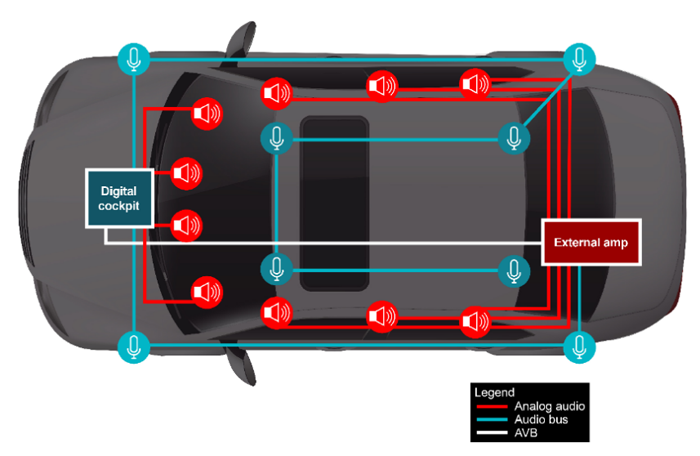Car audio has evolved from purely recreational use to an integral part of the driving experience, designed to improve driver comfort and safety. Audio features such as active noise cancellation (ANC), immersive surround sound, and personalized audio areas, which have traditionally been limited to high-end models, are starting to trickle down to entry-level models.
To keep up with this trend, while making cars more efficient and less difficult to manufacture, original equipment manufacturers (Oems) and audio system designers are finding ways to improve the integration of embedded processors used in automotive amplifiers. These processors need to meet system audio processing requirements as well as OEM information security and functional safety requirements. Sound system designers also want these systems to be scalable, making it easier to redesign between different Oems and model configurations.
In this article, we will explore the evolution of embedded devices such as the Texas Instruments AM62D-Q1 processor and the AM2754-Q1 microcontroller (MCU), and the most important design considerations when using these devices in combination with other advanced semiconductors to develop digital amplifiers in modern vehicles.
Development of automotive audio processors and supporting components
Audio remains a differentiator among Oems. In fact, most Oems will offer kits that upgrade or replace older sound systems, such as premium branded sound systems, branded immersive surround sound features, additional midrange speakers, and subwoofers. If you've recently purchased a car, you're probably familiar with the various audio options available in current models.
In the past, digital amplifiers in high-end car audio systems used a distributed architecture for audio processing, with separate MCUS, digital signal processors (DSPS), and network integrated circuits (ics) handling different tasks. While this discrete approach generally provides design flexibility, it also increases system complexity, cost, and size. To increase immersive surround sound and road noise cancellation (RNC) to deliver a home theater-like experience while optimizing fuel and energy efficiency, the number of components, audio channels, and software types needs to increase. Figure 1 shows an example of a sound system in a modern vehicle with multiple speakers for surround sound and microphones for the RNC.

Single-chip processing platforms also simplify scalability from both a hardware and software perspective, as these MCUS and processor families include pin-to-pin compatible options and support code reuse between different designs.
From a vehicle safety perspective, these devices help improve audio performance outside the vehicle by simplifying the design of sound synthesis systems, such as engine sound synthesis in electric vehicles or acoustic vehicle alert systems. These systems can enhance vehicle safety by emitting sounds that pedestrians can hear from speakers outside the vehicle, as well as the same sounds as engine noise inside the vehicle.
Each C7x DSP core also contains a single-cycle L2 memory cache (with an accessible capacity of up to 2.25MB) that delivers up to four times higher processing performance than traditional scalar-based audio DSPS, and is paired with a matrix multiplication accelerator to form an on-chip neural processing unit (NPU). This architecture can handle both traditional audio algorithms and edge AI-based audio algorithms, enabling multiple high-end audio functions in a single chip.
These advanced audio features also help maintain compatibility with high-performance audio amplifiers such as the TAS6754-Q1 with single inductor (1L) modulation technology, analog-to-digital converters, and power management integrated circuits (PMIC) such as the TPS65224-Q1 to complete the audio signal chain in modern cars. Figure 2 shows a block diagram of a high-end sound system containing TI embedded processors, analog, and power ics.

Conclusion
Highly integrated audio processors with DSP capabilities are enabling a new generation of high-end automotive audio systems to deliver immersive sound, ANC and personalized audio capabilities. However, in order to realize the full potential of these processors, optimized embedded software architectures and development processes are required.
By considering factors such as DSP software architecture, audio framework, tuning tools, and software reuse, automotive systems engineers can unlock the capabilities of advanced audio devices while managing the complexity of on-board system integration. As the demand for high-end audio continues to grow, the focus on hardware and software innovation will be the primary factor in maintaining competitiveness in the automotive market.
Other resources
• Technical article "Using Class D amplifier 1L modulation technology to reduce the design size of car audio system".
About Texas Instruments
Texas Instruments (TI) (NASDAQ: TXN) is a global semiconductor company that designs, manufactures, and sells analog and embedded processing chips for markets including industrial, automotive, personal electronics, enterprise systems, and communications equipment. We are committed to making electronic products more economical and practical through semiconductor technology, and making the world a better place. Today, each generation of innovation builds on the last, making our technology more reliable, economical, and energy efficient, enabling the widespread use of semiconductors in electronics.
免责声明: 本文章转自其它平台,并不代表本站观点及立场。若有侵权或异议,请联系我们删除。谢谢! Disclaimer: This article is reproduced from other platforms and does not represent the views or positions of this website. If there is any infringement or objection, please contact us to delete it. thank you! |


